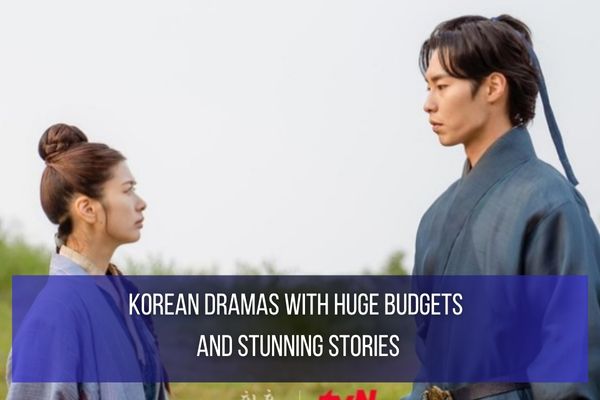
A Bang That Hits Hard
Ever wondered what it takes to build a world that sparks emotion, fills your eyes with beauty, and leaves you gasping for more? That’s exactly what top-tier Korean dramas do—and yes, it takes big money. Think epic costumes, sweeping sets, jaw-dropping effects, and locations that feel like another universe. Intrigued? Let’s dive into the five most expensive K-dramas ever made—and trust me, you’ve probably seen at least one.
Why Big Budgets Matter in K-Dramas
What they do
Money lets creators invest in breathtaking visuals, seamless VFX, complex action scenes, and top-tier actors.
How it impacts you
Sharper storytelling. Bigger emotional payoff. Higher immersion.
Why it’s worth it
When every frame dazzles, you don’t just watch—you feel. And that’s what pulls us back for re-watches.
Moving – Superpowers Meet Production Power
- Estimated budget: 65 billion KRW (about $50M USD)
- Genre: Superhero-action, fantasy
- Highlights: Explosive action, CG that rivals Marvel, layered emotional arcs
This Disney+ Hotstar hit centers on youth with powers who carry secrets—and epic stakes. Every teleport, fire blast, and chase sequence feels cinematic, penned from a webtoon but elevated with blockbuster scale visuals. It’s not every day a K-drama dares Marvel-level effects. And in this case, it delivers.
Arthdal Chronicles – Prehistoric Fantasy With Modern Shine
- Budget: ~54 billion KRW
- Genre: Historical-fantasy
- Watch it if you love: Complex world-building, political intrigue, and Song Joong Ki’s charm
Picture a mythical city, tribes clashing for power, and entire armies battling on giant sets. Mix in CG creatures and rituals that look like fine art. That’s Arthdal Chronicles, and it showed us how far Korean dramas could push costumes, creatures, and cinematography—and still feel deeply human.
Mr. Sunshine – Elegance Meets Emotions
- Budget: ~40 billion KRW
- Genre: Melodrama, historical romance
- Why it stood out: Kim Tae-ri and Lee Byung-hun, expert storytelling, lavish period details
Set in early 20th-century Korea, the show follows a Korean-American major and a noblewoman whose lives collide. From traditional hanbok to artillery smoke and revolutions, it blends romance with sweeping social change, all wrapped in cinematic visuals that whisper Oscar. Standing room only, folks.
Alchemy of Souls – Magic Doesn’t Come Cheap
- Budget: ~40 billion KRW
- Genre: Fantasy, romance
- What to expect: Spiritual possession, lush CGI, breathtaking palace interiors
When mages and soul-swapping rituals take center stage, you need castles, cities, elegant costumes, and seamless effects. Alchemy of Souls delivered all that, creating a visually velvety fantasy that still packed emotional weight. The mix of magic and poignancy keeps it rooted in story, not spectacle.
Kingdom – Zombie Thrills in Royal Settings
- Budget: ~35 billion KRW
- Genre: Historical horror
- Best for fans of: Zombies, political drama, and haunting aesthetics
A mysterious plague turns Joseon-era royals into undead suspects, and the kingdom spirals. The series balances horror chills with political scheming, all while maintaining period-perfect authenticity. If you’ve ever wondered what a zombie apocalypse in a palace looks like—this is it. Netflix nailed it.
What Sets These Dramas Apart
Drama Budget (KRW) Genre Standout Feature
- Moving (65B) Fantasy / Superhero Marvel-style action and effects
- Arthdal Chronicles (54B) Historical Fantasy Grand scale, deep world-building
- Mr. Sunshine (40B) Historical Romance Aesthetics paired with emotional depth
- Alchemy of Souls (40B) Fantasy / Magic Vocally lush visuals and lore
- Kingdom (35B) Historical Horror Realistic aesthetics + zombies
Actionable Viewing Tips
- Want all-out visuals? Start with Moving and Arthdal Chronicles.
- Craving emotional storytelling? Mr. Sunshine and Alchemy of Souls offer deep character journeys.
- Feel like chilling with a twist? Kingdom delivers zombie suspense wrapped in royal intrigue.
The Emotional Bottom Line
These dramas aren’t expensive just for show—they’re investments in immersive worlds that let us live the story. Each one earned fans, gave us viral moments, and showed that spending big can create art that moves us. When visuals meet real emotion, you get K-dramas that don’t just entertain—they stay with you.